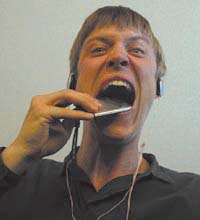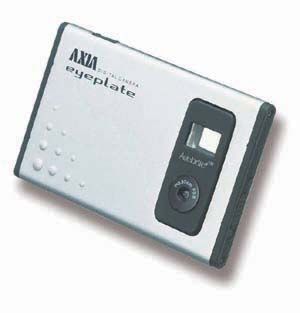Switched On
Back to Contents of Issue: September 2002
|
|
|
|
by Justin Hall |
|
 DURING MY CUSTOMARY FLAWLESS last-minute preparations for international travel, I left my digital camera in a friend's house in Berkeley, California. This friend was nice enough to send it to me, but it was going to take five days to reach Tokyo. Five days without a camera is too long in a place with so much sugary eye candy. I considered working as my favorite Japanese poet Ikkyu, wandering free with a bamboo brush, painting moment by moment poems on wood and stone and paper as they came by. But most of that stuff doesn't scan too well on to the Web. DURING MY CUSTOMARY FLAWLESS last-minute preparations for international travel, I left my digital camera in a friend's house in Berkeley, California. This friend was nice enough to send it to me, but it was going to take five days to reach Tokyo. Five days without a camera is too long in a place with so much sugary eye candy. I considered working as my favorite Japanese poet Ikkyu, wandering free with a bamboo brush, painting moment by moment poems on wood and stone and paper as they came by. But most of that stuff doesn't scan too well on to the Web.So, I headed for Bic Camera in Yurakucho. This electronics store plays its jingle inside the store in a tight forty second loop. Days afterwards I find myself with a sort of consumer Tourette's syndrome, chirping, "Biku-biku-biku bik ka-me-ra!" at odd intervals. I was interested in their selection of cheap digital cameras. It's a sign that digital cameras have reached maturity as a consumer technology that you can buy basic models for under JPY10,000. Expensive digital cameras have strong zoom lenses, big picture previewing screens and loads of buttons; they are capable of shooting short videos and then emailing them through your mobile phone to the International Space Station. These cheapy digital cameras just take pictures. They are wildly light: no LCD screen for previewing pictures, no flash for nocturnal shots; just a thin piece of glass and some chips inside. They are beautiful simplicity, I told myself as I pushed away the memory of my more fancy Nikon CoolPix I had left in the States. That digital camera could take hundreds of pictures, stored on small cards I could pull out and replace like film. It could take a range of photos indoors and then show me what I had so I could delete all the clear shots and save only the blurry. But it was too big to fit in my pocket without appearing to be some sort of abnormal anatomical growth. The smallest of these cheap digital cameras would have been easy to miss if it wasn't so sexy. The Fujifilm Axia Eyeplate camera is 6mm thick -- about the size of three credit cards stacked together. This was the first digital camera I had ever seen that could fit in my mouth. It was light and tiny because it had just the digital camera basics. Holding this thin bit of metal-coated plastic between index finger and thumb, my glasses up against the small viewing hole, I pressed a nearly invisible button and it emitted a small beep. That was it. No focus, no zoom, barely any composition. It holds 24 640x480 pixel photos, but I couldn't see anywhere to insert a battery or memory cards. There's a small hole for a USB connection to a computer and for JPY9,980 it represents attractive, cheap simplicity. 
Of course there was a vocal technology skeptic inside of me that cautioned against the purchase. How good can the photos be? How do you get power to the camera? Isn't it flimsy? But any qualms were outweighed by the price and the incredible thinness. Buying this camera was like buying cheap sunglasses -- you buy them because the style makes you feel good, not because you expect to wear them forever. And the camera was not as bad as I might have expected for the lowest-rung of the digital camera price ladder. Ingeniously, the Eyeplate's battery charges when it's plugged in to the USB port of my computer. This is the same way I get my photos, downloading JPEGs onto my hard drive. FujiFilm even supplies drivers for old or new Windows and Macintosh as well. Sure, the viewfinder often lies, showing me a view of the world from which only a small portion would appear in my final photograph. Sure, it won't take a picture of anything more than mud indoors if there isn't a bank of halogen lights available. But this camera fits in my pocket! I felt like a spy -- able to surreptitiously pull out a slender thing that seemed oddly small to most people and snap photos from the palm of my hand. In the Horyu-ji treasure annex building, I saw an unsettlingly lifelike heavy-lidded kannon. She somehow spoke to me and I wanted to have an image of her face to meditate upon later. But there were rules against cameras here in this gallery. Glancing around nonchalantly, I fished my Eyeplate out of my pocket, popped forward the lens, coughing to cover up the boot-up beeping sound. Then fiddling briefly with it as though it were only a pocket calculator, I switched off the picture-by-picture confirmation beep sound. Standing in front of the kannon statue I took a brief breath, bowed slightly and shot a picture of her face through the glass. When I returned to my laptop later that day to unload the picture, I was rewarded with a murky, blurry shot, showing the kannon cropped from forehead to crotch, with no visible detail save half of the gesture from her left hand. A picture I took immediately before turned out much better -- two schoolkids shuffling their feet through pebbles and dust as a bespectacled monk worked to rake the ground smooth next to them. This photo was taken outdoors, as the sun shone on a large aged wooden pagoda. The world's oldest wooden structure photographed with the world's thinnest camera. I took this photo without anyone's permission, but it's hard to feel like a spy in broad daylight. Later, at the foot of the world's largest statue of Buddha, a behemoth seated figure pronouncing non-attachment to worldly goods, other visitors marveled at my Eyeplate. "That thing takes pictures?" they asked. Now that I've seen my pictures from that day, I'd have to reply "Well, sorta." The Eyeplate feels like it would be an ideal personal surveillance tool but for the middling quality of pictures taken in non-ideal circumstances. It doesn't compare to a full-price camera; it just can't handle medium or low light -- most indoor situations, especially stealth ones. It's best as a convenient photo forget-me-not; it served me best when I needed a quick snapshot of something nearby, outside on a sunny day. I always carry an over-the-shoulder bag containing my notebook and Nikon camera. When the Eyeplate quality improves, maybe I'll ditch my man-purse for this slender camera in my pocket. Though, once I got my other digital camera back, I was still excited to have my Eyeplate. I carried it around with me and showed my friends: "Look how small this camera is..." @ |
|
Note: The function "email this page" is currently not supported for this page.





